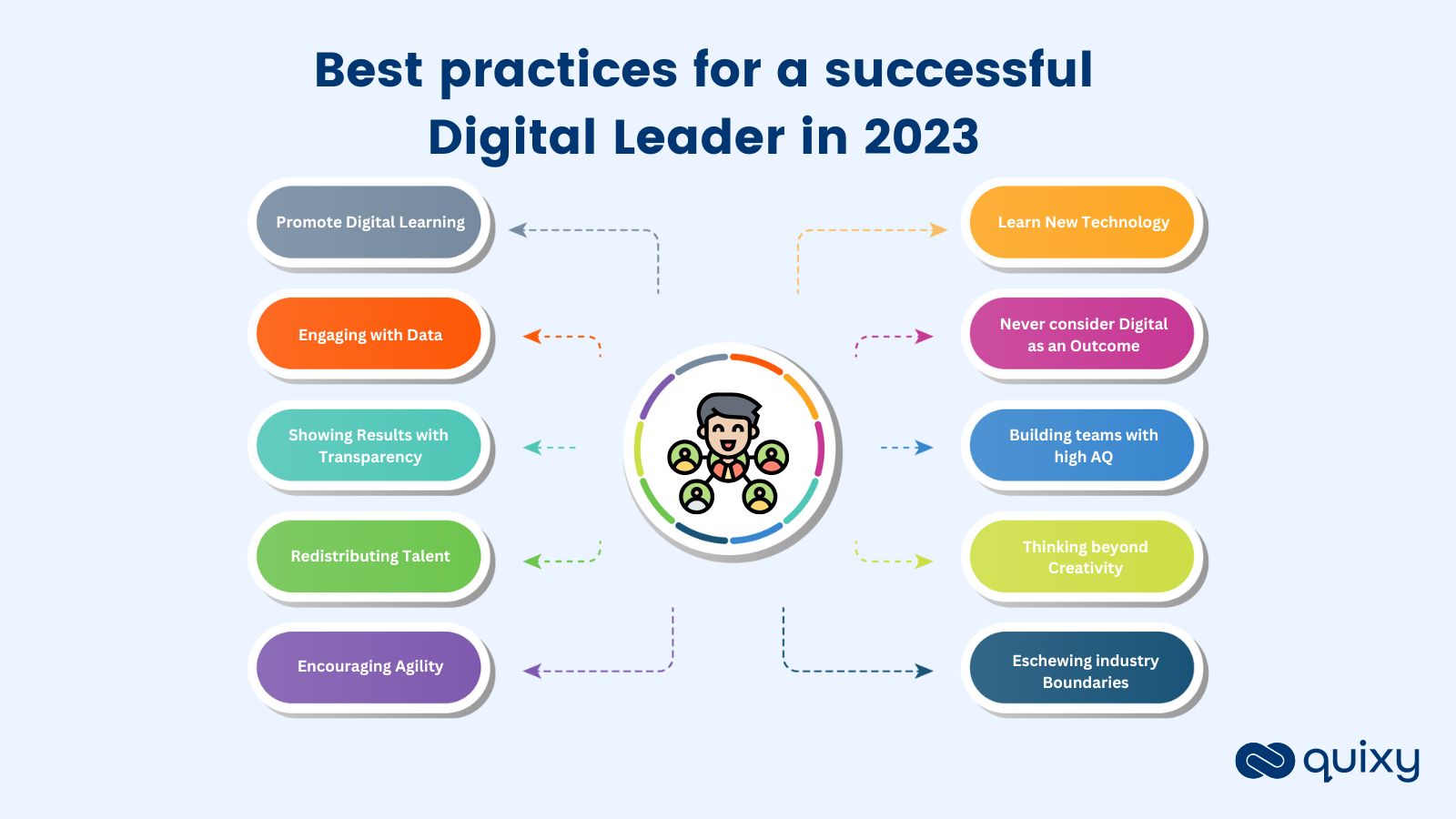
The majority of leaders that we are aware of have a robust and intuitive sense of the pulse of their companies. They are adept at moving their company, driving execution, and pulling strategic levers hard and quickly to achieve their goals. Indeed, they did. With information-gathering methods that are too slow or disconnected, direction-setting strategies that are too timid, and talent-management practices that are inconsistent and gradual, digitization has accelerated the rhythm of competition in many industries, leaving leaders adrift. Wondering how can digital leadership practices revolutionize innovation, navigate technological shifts, and inspire transformative change in the digital age? Explore the key strategies and insights to embark on this transformative journey.
Digital leader in 2025 understands that their organizations must change and grow. Profit pools are under strain as a growing portion of the value is transferred to customers digitally. Furthermore, those profit pools are crossing traditional industry boundaries due to business alliances made possible by modern technologies, which alters who in the value chain benefits financially, what portion of the pie they take, and how. The ineffective and slow are left behind, vying for scraps.
However, these leaders need to learn how much or how quickly to change their business routines. The advice to “transform at the speed of digital” causes more concern than it does solutions. Our current research offers clear direction: digital leaders maintain a drumbeat in their organizations that can be twice as powerful and four times faster than their counterparts.
Mastering Digital Leadership Practices
We have found 11 strategic and operational principles strongly associated with the effective implementation of digital initiatives. The top decile of organizations for organic revenue growth, as determined by their responses, indicate that adaptable cultures that are at ease with change, constantly learning, and quick to respond are closely related to the accelerated repetition of some important behaviors.
These actions can be divided into two groups. One is a series of steps that a business must consistently take (monthly or even weekly) to raise the organization’s pulse. The second entails taking a step back to analyze all the business has learned and then making significant adjustments or realignments. These actions are done irregularly (often quarterly).

Promoting Digital Learning
As was previously said, those who are not digital natives find it difficult to keep up with emerging technologies. The digital leader should promote learning of the abilities needed to survive, learn, and work in the digital world to make it simpler for them.
It’s also crucial for digital leaders to supply the required tools and methodologies, such as citizen development, which enables non-IT professionals to employ no-code technology to update apps and operational procedures quickly.
Engaging with Data
To find new ways to win over customers, over half (44%) of digital leaders collect and analyze customer data weekly (or more regularly), compared to just 16% of laggards who, on average, examine customer data only monthly. Also, the need for urgency is constant. For instance, a business with 2,000 consumers in its database decided to promote online sales by providing a coupon code. Instead of just sending one email to its clients, it experimented with two separate promotional offers, each of which required customers to act more quickly than the others. The more urgent offer produced a response rate that was 60% higher and set the bar for all subsequent promotional emails.
Also Read : Tips to Overcome IT Leadership Challenges
Sharing Results with Transparency
Digital leaders encourage staff to share their lessons and wins from their innovative projects (for example – using no-code platforms to build applications) to permeate a culture of agile development in the whole organization. Top digital leaders are more likely to do this every week, no matter how simple it may seem. Additionally, they are dedicated to disseminating any lessons learned via test-and-learn exercises to the rest of the business. Digital leaders should share expertise weekly and do that three to four times as quickly as their peers—at least monthly.
Redistributing talent
Digital leaders redistribute digital talent quarterly or more frequently, which is more than five times faster than what their peers do. Most businesses wait a year or longer before redistributing talent. This wide disparity will likely increase as more businesses employ agile techniques outside of IT. Agile ensures that companies form compact, diverse teams focused on the same objectives. These teams regularly manage their backlogs of the most important tasks to accomplish important results while making iterative progress. Their approach lowers the risk associated with tough decisions while enabling rapid, extensive reprioritization of digital endeavors.
Also Read: 75+ Digital Transformation Statistics and Trends To Help You Navigate
Encouraging Agility
An agile workplace has enabled the Dutch financial organization ING to completely reimagine how it provides customer service.
Cross-functional “squads” of nine or fewer individuals concentrate on providing solutions for particular client demands in ways that were not conceivable in the previous organization. Squads with common goals (such as mortgages, payments, or consumer credit) are grouped into “tribes” of 150 or fewer employees. Talent reallocation is carried out quickly and with an emphasis on value. Each tribe has a leader who can dispatch essential resources, such as IT engineers. These tribal leaders meet once every three months for a business review (QBR). Before the QBR, tribe leaders distribute a brief note to all of their peers outlining the accomplishments of the tribe over the previous three months as well as its failures and shortcomings.
Additionally, they write their commitments for the upcoming quarter and list the materials and assistance they will need to meet these challenging objectives. The bank’s top management redistributes people to the tribes with the best opportunities based on this information and related dialogues. The procedure has sparked productivity and innovation, and this is definitely an ideal case study for a digital leader in 2025 to follow.
Geeking out on Technology
This quality is frequently overlooked. To assess where the opportunities are, digital leaders truly need to have a deep understanding of technology. This is crucial when figuring out what AI or other technologies can do for you or their effects on the company. However, not just leaders but also their followers should embrace their inner geek.
Asking employees about their hobbies and free time is a good idea. Perhaps they are using a no-code platform to build applications independently, or someone else routinely blogs about technology in their spare time but has never brought it up in a work or professional setting. This could generate insightful comments, particularly from younger employees who might have more spare time.
Also Read: From Coding to Strategic Leadership: Quixy Levels Up Your IT Game
Never consider Digital as the Outcome
Digital is merely a tool and a way of achieving an objective. No one transforms simply to be transformed, and no one digitizes simply to be digital. Make sure to define and explain the rationale for digitizing. Digitization can lead to undesirable outcomes without a definite, hard-edged purpose. For instance, many people dislike online grocery shopping because they prefer to browse the aisles, find it tedious to click on every item, or prefer to be startled by an impulse purchase.
Consider what you’re trying to optimize or what the expected outcomes are to avoid “doing digital” only for being “digital.” You might aim to raise profits, margins, transparency, or security, among other things. Do you use digital to get where you’re going? Digital is not a destination for this reason.
Building teams with high AQ
The adversity quotient(AQ) is less commonly measured by leaders than the intelligence quotient (IQ) and emotional quotient (EQ). AQ gauges a person’s grit and ability to bounce back after adversity. Because the nature of digital transformation frequently disturbs how people operate by breaking conventions and challenging preconceived notions, high AQ lends itself to higher staff retention, which is essential for digital leadership.
High-performance athletes are frequently instructed to imagine both the positive and negative to help them become more resilient in high-pressure circumstances. What other circumstances might arise that might cause me to lose focus? What if the lineup is interrupted, or I develop a foot splinter the day before? Resilience can be improved by visualizing all probable setbacks and “practicing how I might come back from those.”
By introducing a small amount of unexpectedness, coaching, and exploring various challenges and adjustments, you can improve your AQ. Give folks the means to overcome challenges so they are only partially knocked off course when things go differently than planned. Being resilient is a quality we need more than ever to get us through the protracted, chronic phase of the COVID-19 problem.
Also Read: 7 Traits of Successful Digital Leaders
Thinking beyond creativity
There is a belief that creativity and innovation can coexist; therefore, innovation will follow if you have creative individuals. Innovation requires five different actions in addition to creativity. The ideas will come from imagination, but you also need courageous behavior to ask, “Why would we do this? Is this genuinely helpful? Could we sell this to someone?
You’ll require collaboration to bring together multiple disciplines and separate elements of the organization, in addition to challenging conduct. Construction, or the actual building part, is the fourth behavior; the last thing you need is people to market this innovation.
You’ll need all five characteristics, not imagination, to create and promote a product. Conduct an audit to ensure your staff has the necessary skill sets in each area. It’s simple to overstate some behaviors.
For instance, during COVID-19, people may exhibit more problematic behavior just out of exhaustion, or your team may be excellent at coming up with a proposal but awful at selling it to customers. To fill the holes, identify them and bring in teams.
Eschewing industry boundaries
Consideration of the organization’s perspective, innovation potential, business model, or digital transformation based on an industry point of view might be a trap. Like Facebook, Amazon, and Google, many high-performing digital CEOs don’t care what sector they’re in. Instead, they are focused on what needs their consumers have that they can fill. Traditional industry boundaries are not at the center of what they do; rather, it is their customer.
Industry classifications like “financial services” can be misleading in identifying new prospects since they place more emphasis on what already exists than what does not. The best places to innovate are frequently between existing things, and that space cannot be filled with compelling new offerings using an industrial lens. But a focus on client needs might.

Conclusion
There is no doubt that organizations across industries will undergo a digital transition. However, any firm can easily adapt to this change if it has a solid digital transformation strategy and strong digital leadership capabilities. A successful digital leader in 2025, when following the best practices mentioned above, can help their team outperform expectations in the changing business environment.
Quixy, an advanced no-code platform, can help digital leaders lead their organization’s growth in an agile way. It will help them create an innovative environment where business users create solutions independently. Get started with our platform, and experience the ease of automated processes and personalized app building.
Subscribe
Login
Please login to comment
0 Comments
Oldest
















